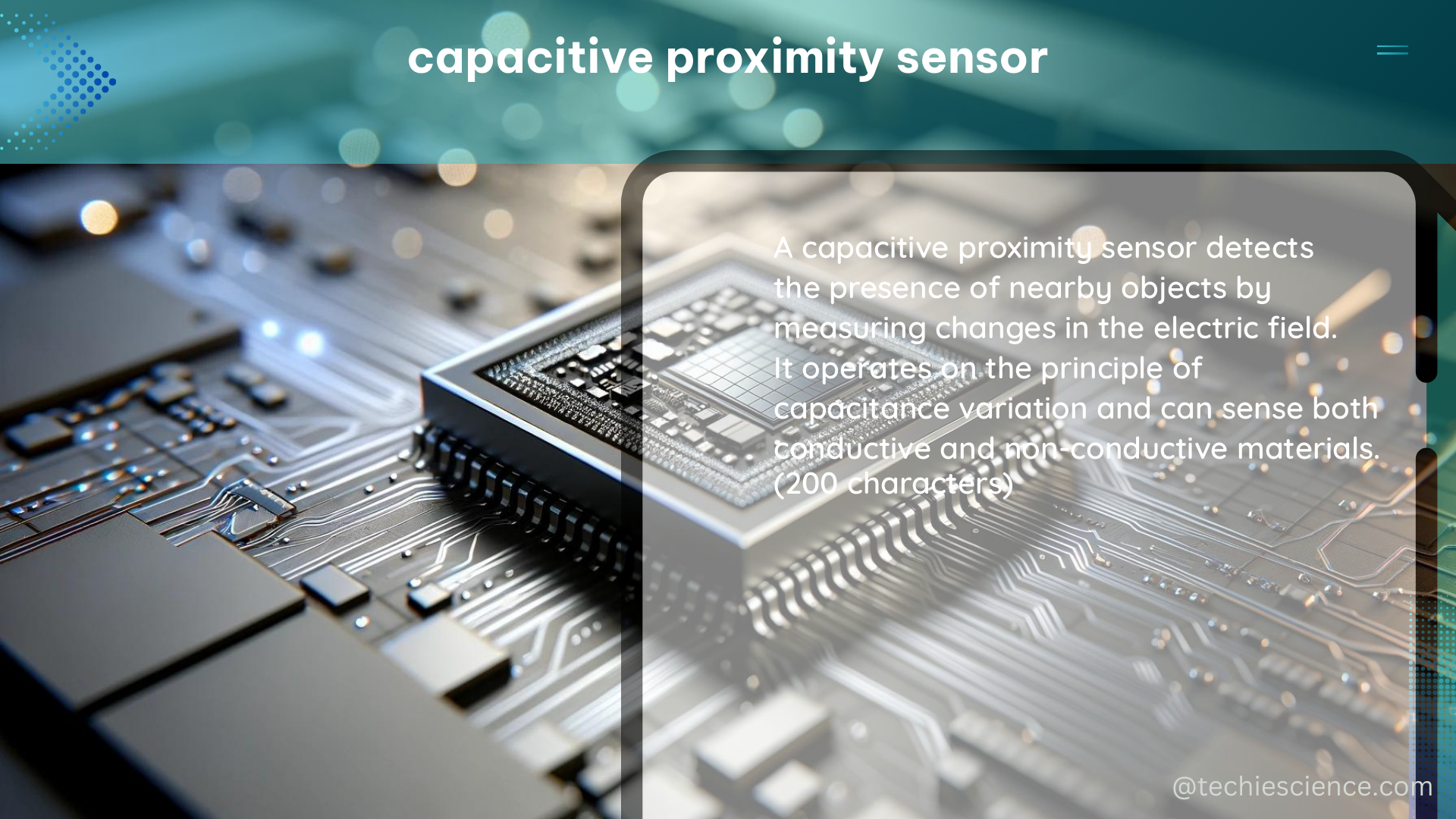Capacitive proximity sensors are a type of sensor that can detect the presence and position of nearby objects by sensing changes in an electric field. These sensors operate by measuring the capacitance between their own electrode and the ground, and when an object approaches, the capacitance changes, which the sensor can detect. The sensitivity of these sensors can be affected by various factors, including the size and shape of the sensor and the object, the distance between them, and the presence of other conductive objects nearby.
Understanding Capacitive Proximity Sensors
Capacitive proximity sensors work by creating an electric field between the sensor’s electrode and the ground. When an object approaches the sensor, it disrupts this electric field, causing a change in the capacitance between the electrode and the ground. The sensor can then detect this change in capacitance and use it to determine the presence and position of the object.
The sensitivity of a capacitive proximity sensor is typically measured in femtofarads per micrometer (fF/μm), which represents the change in capacitance per unit of distance. This value can vary depending on the specific sensor and its configuration, as well as the properties of the object being detected.
For example, a micro-electro-mechanical capacitive proximity sensor with a size of 500 × 50 μm and an electrode width of 10 μm has a sensitivity of 0.48 fF/μm. This means that for every micrometer of distance change between the sensor and the object, the capacitance will change by 0.48 femtofarads.
Factors Affecting Capacitive Proximity Sensor Performance

The performance of a capacitive proximity sensor can be affected by a variety of factors, including:
-
Sensor Size and Shape: The size and shape of the sensor can have a significant impact on its sensitivity and detection range. Larger sensors generally have a higher sensitivity and detection range, but they may also be more susceptible to interference from nearby objects.
-
Object Size and Material: The size and material of the object being detected can also affect the sensor’s performance. Larger, more conductive objects will typically have a greater impact on the sensor’s electric field, resulting in a larger change in capacitance.
-
Distance between Sensor and Object: The distance between the sensor and the object being detected is a critical factor in determining the sensor’s performance. As the distance increases, the change in capacitance will decrease, reducing the sensor’s sensitivity and detection range.
-
Parasitic Capacitance: Parasitic capacitance, which is the unwanted capacitance between the sensor’s electrode and other conductive objects in the environment, can interfere with the sensor’s performance and reduce its sensitivity.
Mitigating Parasitic Capacitance
One important factor to consider when designing and using capacitive proximity sensors is the effect of parasitic capacitance. Parasitic capacitance can cause interference and reduce the sensitivity of the sensor, which can be mitigated through the use of active shielding.
Active shielding involves adding a shield electrode around the sensor electrode and driving it at the same voltage potential as the sensor input. This helps to reduce interference and direct the sensing zone to a particular area, improving the performance of the sensor.
For example, a study by Texas Instruments found that using active shielding can reduce the effect of parasitic capacitance by up to 90%, significantly improving the sensor’s sensitivity and detection range.
Advanced Capacitive Proximity Sensor Designs
In addition to the basic design of capacitive proximity sensors, there have been several advancements in sensor technology that have improved their performance and capabilities. Some examples include:
-
PET-PDMS CP Coating Sensors: These sensors use a PET-PDMS (polyethylene terephthalate-polydimethylsiloxane) coating to create a capacitive proximity sensor with a detection range of up to 13 cm and a response time of less than 100 ms.
-
TPU-CNT Sensors: These sensors use a TPU-CNT (thermoplastic polyurethane-carbon nanotube) material to create a capacitive proximity sensor with a detection range of 2-22 cm and a response time of less than 30 ms.
-
Coplanar Capacitive Proximity Sensors: These sensors use a coplanar design, where the sensor electrode and the ground electrode are on the same plane, to detect the gap between dielectric foils with high accuracy.
-
Micro-Electro-Mechanical Capacitive Proximity Sensors: These sensors use micro-electro-mechanical systems (MEMS) technology to create highly sensitive and compact capacitive proximity sensors, with a sensitivity of 0.48 fF/μm.
Conclusion
Capacitive proximity sensors are a versatile and widely used type of sensor that can detect the presence and position of nearby objects by sensing changes in an electric field. These sensors can be affected by a variety of factors, including sensor size and shape, object size and material, distance between the sensor and object, and parasitic capacitance.
By understanding the key factors that affect capacitive proximity sensor performance and the various advanced sensor designs available, engineers and researchers can design and implement highly effective and reliable capacitive proximity sensing systems for a wide range of applications, from industrial automation to consumer electronics.
References:
- Texas Instruments. (2022). Capacitive Sensing: Ins and Outs of Active Shielding (Rev. A). Retrieved from https://www.ti.com/lit/an/snoa926a/snoa926a.pdf?ts=1705676488690
- Haque, R. I., Lubej, M., & Briand, D. (2022). Design and printing of a coplanar capacitive proximity sensor to detect the gap between dielectric foils edges. ScienceDirect, 4(1), 100062.
- Moheimani, R., Hosseini, P., Mohammadi, S., & Dalir, H. (2022). Recent Advances on Capacitive Proximity Sensors. MDPI, 8(2), 26.
- Baxter, L. K. (1997). Capacitive Sensors: Design and Applications. IEEE Press.
- Fraden, J. (2016). Handbook of Modern Sensors: Physics, Designs, and Applications. Springer.

The lambdageeks.com Core SME Team is a group of experienced subject matter experts from diverse scientific and technical fields including Physics, Chemistry, Technology,Electronics & Electrical Engineering, Automotive, Mechanical Engineering. Our team collaborates to create high-quality, well-researched articles on a wide range of science and technology topics for the lambdageeks.com website.
All Our Senior SME are having more than 7 Years of experience in the respective fields . They are either Working Industry Professionals or assocaited With different Universities. Refer Our Authors Page to get to know About our Core SMEs.